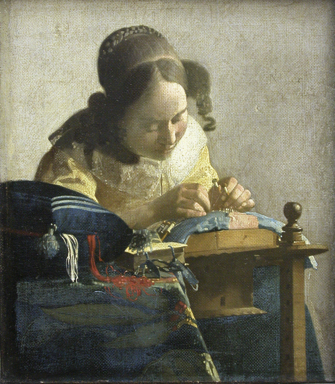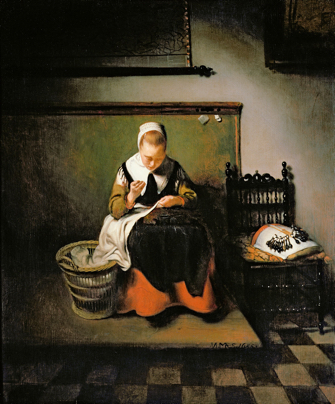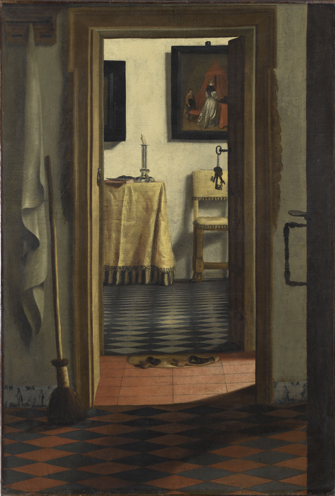
What is it about Vermeer that fascinates us so much? Is it the scarcity of his paintings? The mystery of the life of the artist dubbed “The Sphinx of Delft” by 19th-century art critic Théophile Thoré-Bürger? Or is it the way his paintings make us feel as we contemplate them and are drawn into a world of peaceful concentration? I vote for the latter. The wonderful exhibition that opened at the Louvre last week offers us 12 of Vermeer’s extant 34 paintings, all a joy to behold, accompanied by works on related themes by his contempor-
aries.
This interesting and instructive exhibition goes far in showing us how the artists of the Dutch Golden Age borrowed from each other and adapted subjects and techniques, as artists always have done and always will do.
Those contemporaries were no slouches, but somehow in each room you enter, it is the work by Vermeer that leaps out at you. Although that effect may be due to the fame and familiarity of his relatively few paintings, I think it goes beyond that.

Vermeer was a genius at suggesting rather than showing everything, and he worked with an economy of expression that not all of his Dutch counterparts mastered. Just compare two of the paintings on this page, Vermeer’s “The Lacemaker” (c. 1669-70) above and “Young Woman Sewing” (1655), by Nicolas Maes.The Maes painting is lovely, with the girl concentrated on her task bathed in a circle of light from an unknown source amid dark surroundings. But just look at the way Vermeer zooms in on his subject in “The Lacemaker,” stripping out the extraneous. We feel her total concentration and almost enter into it. There are few distractions, not because they disappear into dark corners as in the other painting, but because of the tight focus on the woman, her hands and her handiwork.
Looking at this painting for a long time had an almost physical effect on me, slowing everything down and filling me with a feeling of pure calmness.
This masterpiece, by the way, belongs to the Louvre (as does Vermeer’s “The Astronomer”), and once the exhibition has finished touring, it will once again be on display in Paris.

Many of the Vermeer paintings in the show inspired the same feeling, especially “Women Holding a Balance” (c. 1664), which opens the show; “Woman with a Pearl Necklace” (1663-64); and “A Lady Writing a Letter, with her Maid” (c. 1670). In the latter, a woman sits at a table, intent on writing a letter, apparently in a fit of passion (a crumpled letter bearing the red seal of the sender has been thrown to the floor, and she is sitting in an apparently unaccustomed place for writing, where the light falls so that her hand would cast a shadow on the page).
Contrasting with her intensity is the placid pose of the servant standing behind her, taking advantage of her mistress’s distraction to steal a glance out the window. The light from the window picks out the two women, while the rest of the room remains in shadow, so that the painting on the wall behind them, “The Finding of Moses” – thought by some critics to represent a theme of reconciliation, perhaps the hoped-for goal of the letter being written – is hard to make out.

The works by other painters surrounding each of the 12 Vermeer paintings include many wonderful pieces by such masters as Jan Steen (notably his provocative “Woman at her Toilet”), Pieter de Hooch, Gerard Dou, Frans van Mieris (a number of exquisite works), Samuel Van Hoogstraten (his lovely “View of an Interior, or The Slippers” is one of the few paintings with no humans in it), Gerard Ter Borch and several others.
We would certainly be thrilled to see paintings by these artists at any time, but Vermeer’s still speak strongly to us from across the centuries – ironic considering that he was pretty much forgotten until his rediscovery in the 19th century – perhaps because there is something eminently modern about them.
Two of Vermeer’s most famous paintings, “View of Delft” (1660-61) and “Girl with a Pearl Earring” (1665), are, alas, not included in the show, but we can only be thankful that we have so many of them gathered together in Paris.
After it ends at the Louvre on May 22, this exhibition will travel to the National Gallery of Ireland and then the National Gallery of Art in Washington, D.C. In the meantime, we are being spoiled here with a feast of works from the Dutch Golden Age at the Louvre: “Masterpieces of the Leiden Collection: The Age of Rembrandt” (through May 22) and “Drawing the Everyday: Holland in the Golden Age” (March 16-June 12).
Favorite